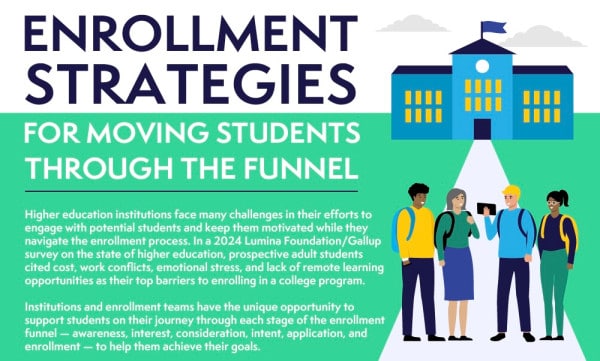Top Student Enrollment Roadblocks and How to Overcome Them
In my more than two decades of steering enrollment management at various institutions, I’ve seen students encounter numerous hurdles on their journey to and through higher education.
My experience has consistently shown that the decision to enroll is heavily influenced by four critical factors:
- The ease of the enrollment process
- A transparent path to graduation
- A reasonable time frame for degree completion
- A clear cost-benefit analysis of the educational offering
Understanding these priorities is critical to attracting and retaining students in the community college space. By aligning your enrollment strategies with the needs and expectations of prospective students, you can ensure a smoother, more engaging educational journey that benefits both the students and your educational institution alike.
Common Ease of Enrollment Roadblocks for Students
The pursuit of higher education is a daunting task in itself. When students encounter challenges at the enrollment phase — before the actual coursework even starts — it can be easy for them to bow out of the process altogether. To ensure that doesn’t happen, avoid these common pitfalls in the community college enrollment journey:
Complex Enrollment Processes
- Lengthy admissions procedures: Complicated and time-consuming application processes can frustrate new students, especially those unfamiliar with higher education procedures.
- Document submission delays: Students may struggle with gathering and submitting the required documents (e.g., transcripts, proof of residency) on time, leading to delays in their enrollment.
Orientation and Information Overload
- Overwhelming orientation sessions: While orientation programs are meant to help new students, they can be overwhelming if they cover too much information in a short time, leaving students confused about where to start.
- Missed information: Students may miss important information about resources, deadlines, and processes if the information is not communicated clearly, or if the students do not attend orientation sessions.
Confusing Websites
- Sites overloaded with information: Websites designed to serve multiple audiences — current students, alumni, faculty, and potential students — can make the inquiry stage difficult and confusing for prospective students. They may become frustrated as they struggle to find specific information or complete essential tasks, which can lead to them delaying or abandoning the process.
Placement Testing Delays
- Test scheduling issues: Placement tests in subjects like math and English are often required before students can register for classes, but delays in scheduling or students misunderstanding the requirements can slow down the process.
- Preparation for tests: Some students may need to brush up on certain skills before taking a placement test, and may be unaware of resources or study options available to them, making this a barrier for them.
How to Overcome Ease of Enrollment Roadblocks
So, those are the potential enrollment roadblocks for community college students. But what are the enrollment solutions? Solutions for overcoming enrollment roadblocks for community college students include the following:
- Create a “Future Students” platform: Build a page or digital experience that is 100% focused on educating and helping individuals who are simply exploring their educational options. Below are just a few examples of topics that prospective students might want to be able to easily find information about on your “Future Students” page or experience:
- When can I start?
- How much does it cost?
- What support services are available?
- What is the application process and deadline?
- What are the specific steps I need to take to be prepared for the start of the term?
- What happens after I apply?
- Create mobile-friendly applications: Simplify the application itself, and ensure that students can use their mobile device to complete the application, apply for financial aid, register for orientation and/or courses, and order their books.
- Apply technology solutions: Use simple and low-cost systems to track students’ progress through the onboarding process, identify at-risk students, and automate follow-up communications.
- Use data analytics: Analyze data to identify common drop-off points as new students navigate the onboarding process, and tailor interventions to address these specific challenges.
Common Clear Path to Graduation Roadblocks for Students
Now that you’ve mowed down the enrollment roadblocks, it’s time to ensure that the ride stays smooth. Remember, it’s never too late for students to change their direction. They might do so if these issues persist:
Course Registration Problems
- Limited course availability: Popular or required courses may fill up quickly, leaving new students without the courses they need, which can delay their academic progress.
- Complex registration systems: A complicated online registration system can be difficult for students to navigate, leading to errors or incomplete registrations.
- Prerequisite confusion: Understanding which courses have prerequisites and ensuring those are met can be a hurdle for new students unfamiliar with academic requirements.
Technology Barriers
- Difficulty navigating online platforms: New students may struggle with using the college’s online portals for registration, financial aid, course management, and other essential functions.
- Limited digital literacy: Students with limited experience using digital tools may face challenges in accessing online resources and completing necessary tasks.
How to Create a Clear Path to Graduation
Constructing a clear path to graduation isn’t easy, and with limited resources, it can be difficult to avert every bump in the road. But in my experience, you can keep most students on track by focusing on these two key areas:
- Create academic maps: Complete an analysis that maps out all of your institution’s programs, courses, campuses, modalities, and times of day (day versus evening courses). Make sure all students can clearly see what courses they need as well as how, when, and where they can take the courses in order to reach their educational goals.
- Make integration the top priority: Really cool software options exist that are designed to help students stay on track. But if they don’t integrate with your existing systems, steer clear. You’re only going to confuse your students with disjointed information.
Common Reasonable Degree Completion Roadblocks for Students
You’ve cleared two major hurdles by easing the enrollment process and creating a clear path to graduation. But you’re only halfway home. Here are some common mistakes institutions make when it comes to the time it takes to complete a degree:
Inadequate Academic Advising
- Limited access to advisors: New students often need guidance on how to choose the right courses, but they may struggle to get timely appointments with academic advisors due to high demand.
- Lack of personalized guidance: Some students receive generic advising that doesn’t take their individual needs and goals into account, leading to poor course selection or misaligned academic paths.
Lack of Clear Communication
- Inconsistent information: Conflicting messages from different departments (e.g., admissions, financial aid, advising) can create confusion and frustration among students.
- Unclear next steps: Students may not know what steps to take after completing their initial tasks, which can lead to delays in moving forward with the enrollment process.
Social and Emotional Challenges
- Anxiety and uncertainty: The transition to college can be intimidating, especially for first-generation students. Without proper support, students may feel overwhelmed and unsure of how to proceed.
- Lack of connection: Feeling disconnected from the campus community can hinder a student’s willingness to engage and complete the onboarding process.
How to Help Students Reach Their Goals in a Reasonable Amount of Time
When it comes to keeping students on track, intervention is key. Follow these tips:
- Educate students early: Help students realize that taking two courses per term may not be enough to earn their degree in the time frame they set for themselves. Make them aware of initiatives such as “15 to Finish” or “Momentum Year,” as well as other ways to receive college credit, such as through a prior learning assessment. These topics can all be part of the “Future Students” experience mentioned above in the “Ease of Enrollment” section.
- Keep students focused on the end goal: Post each student’s expected graduation date within their degree audit so they can see that taking two courses per term will put them on pace to earn an associate degree in five years.
Common Cost/Benefit Roadblocks for Students
You’ve now reached the last but never the least critical roadblock in higher education: return on investment. It’s why your students are showing up, and if the numbers don’t make sense, they can — and should — turn back. Here are some financial concerns that your students are likely to face:
Housing and Transportation Challenges
- Affordable housing: Students who need housing may have trouble finding affordable options, which can delay their ability to start classes.
- Transportation barriers: Students without reliable transportation may struggle to attend orientation sessions, placement tests, or even some of their classes.
Cost of College Data Is Hard to Find
- How much a degree costs: Some students don’t know what a college credit is, much less what a cost-per-credit model is. Furthermore, many students don’t know how many credits it takes to earn a degree/credential.
- Payment options: Students may not know that different financial options exist. This is especially true for students who work full time for an employer that provides tuition assistance as a benefit.
Ways to Help Students With Their Financial Concerns
Your institution is responsible for ensuring that students understand their financial obligations and how to meet them. Here are a few ways that you can do this:
- Provide clear cost comparisons: Create easy-to-understand charts or infographics that compare the cost of tuition and fees at your community college to those at local four-year universities. Highlight the significant savings.
- Offer cost calculators: Provide online calculators that allow students to input their financial information and compare a community college’s costs to a four-year institution’s costs. See an example here.
- Provide debt-projection tools: Offer tools that project potential student loan debt based on different educational paths, clearly illustrating the financial advantages of the community college option. Remember that you are an educator and that education starts the moment a student begins exploring your college.
Bust Down Roadblocks by Partnering With Archer
In my 20 years of experience, I’ve helped lots of institutions navigate these potential roadblocks to enrolling and retaining more students. And I’m far from alone in my expertise at Archer. Our full-service team partners with colleges of all kinds to help them build and scale their capacities.
Is your institution ready for a collaborative partner who takes the time to get to know you, then makes custom recommendations based on decades of experience? Reach out to us today!



